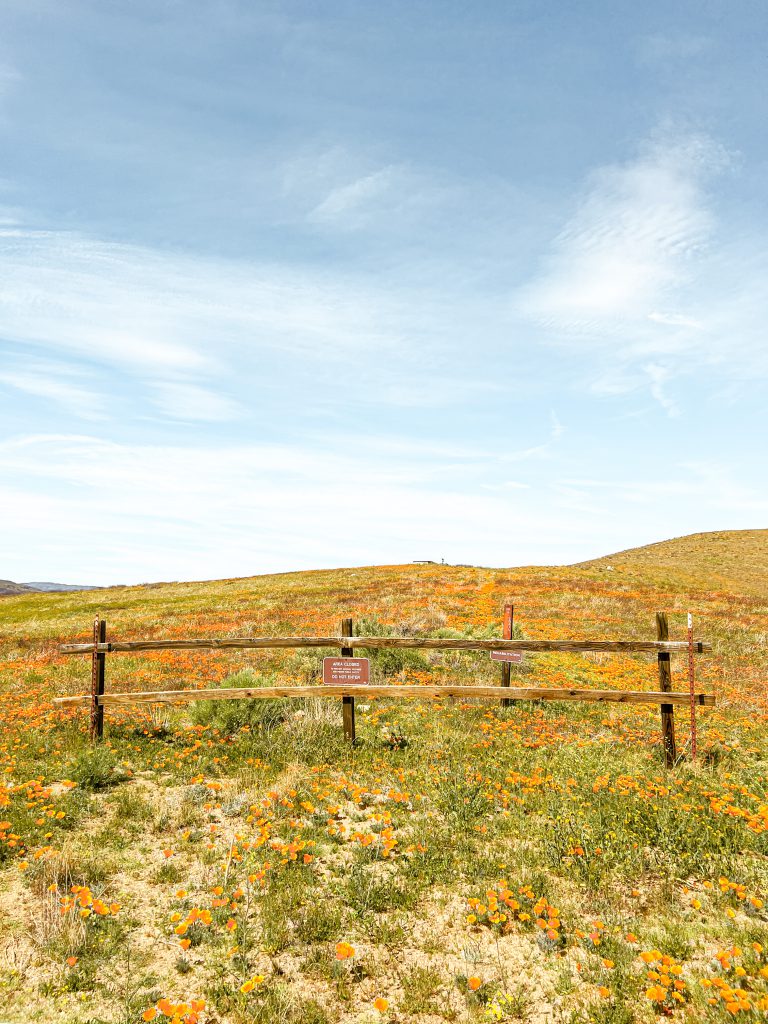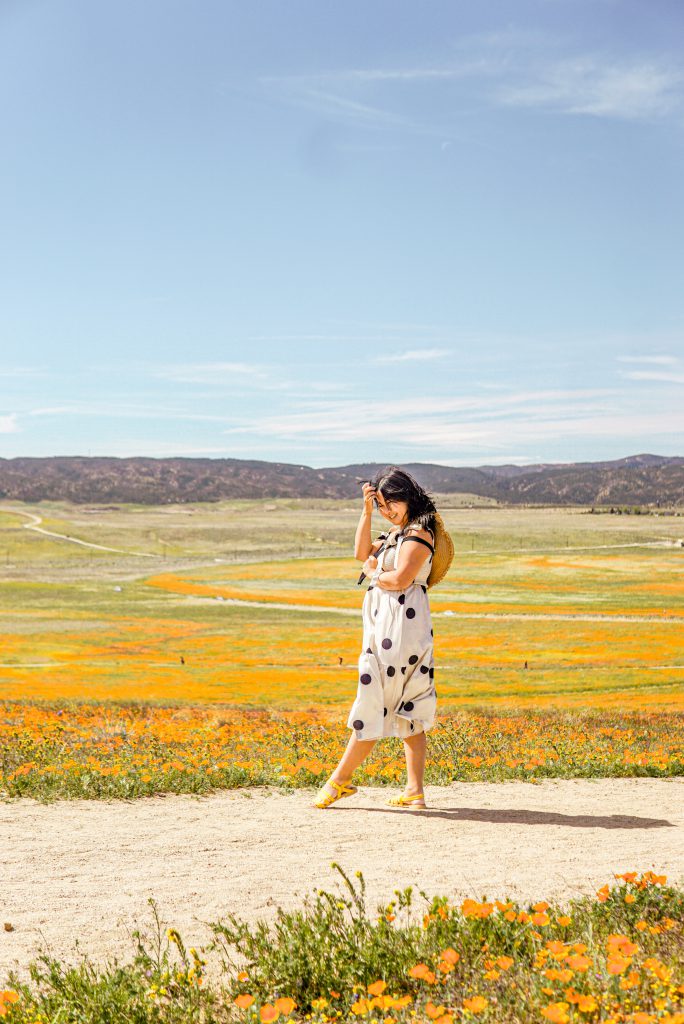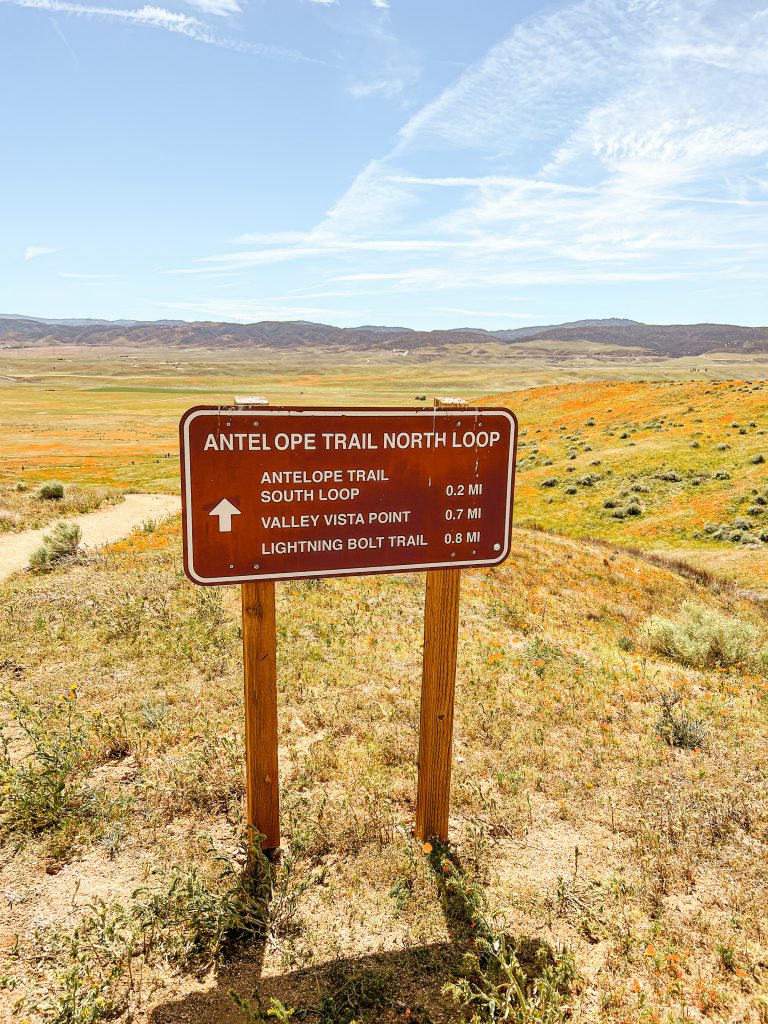
Ahhh, there’s nothing quite like spring in California. It’s by far my favorite season – I love seeing the explosion of colors thanks to spectacular floral blooms seen throughout the state. One of my favorite sights is the Lancaster poppy fields, which boasts an impressive display of the iconic California poppies.
I can never say no to colorful blooms, and definitely are spoiled in the spring in Southern California – we’ve got the ranunculus flowers in Carlsbad, the wild mustard in Chino Hills, the cherry blossoms at the Huntington Library in Pasadena, and the wildflowers blooming in the state’s national parks, including Joshua Tree, Death Valley, and more.
But one of the most impressive is seeing the California poppy, the official state flower, blooming across acres at the Antelope Valley Poppy Reserve. The park is known as one of the best places to see poppies in California because it is the most consistently poppy bearing land in the state. .
It is especially spectacular during a superbloom year. Sadly, it was not a superbloom when the year I went but it was still a pretty amazing sight! The hillsides become blanketed in a vibrant orange color, and it is truly a magical sight – it was pretty breathtaking and something everyone should see at least once!
Want to take a trip out to see the Lancaster poppies (trust me – you definitely should!)? Here is everything you need to know about visiting the Lancaster poppy fields – from the best time to visit the Antelope Valley Poppy Reserve, the best spots to see them, tips for visiting, and more!
This post contains affiliate links. This means that if you make a purchase or booking, I may receive a small commission at no additional cost to you. Pictures & Words is a participant in the Amazon Services LLC Associates Program, an affiliate advertising program designed to provide a means for us to earn fees by linking to amazon.com and affiliated sites at no cost to you.
How to see the Lancaster poppies


About the California poppy
The California poppy is one of the most iconic symbols of California. Named the official state flower on March 2, 1903, California poppies are sometimes seen as a representation of the “fields of gold” that were often sought after during the Gold Rush.
The flowers are native to the Pacific slope region, from the Baja California region in Mexico all the way up into Oregon, but can also be found in many other states in the U.S.
The California poppy was first discovered and named by Adelbert von Chamisso, a naturalist aboard a Russian exploration ship. Chamisso gave the flower its scientific name, Eschscholzia californica, named after the ship’s surgeon and entomologist.
While often recognizable by its iconic orange color, there are multiple varieties of California poppies, which can be pale yellow, orange, and cream in color. Cultivated varieties can also be found in white, pink, and red as well.
California poppy flowers open their petals in sunlight and warm weather, and close back up at night and on cloudy days.
Wild California poppies are often found all throughout the state during the spring and summer months. Seeds are germinated with rainfall in the fall and winter, as well as warm soil in the spring. Summer heat turns the poppies dormant until favorable conditions are reached again. Each poppy flowers contains up to 200 seeds for next year’s bloo.
Visiting the Lancaster Poppy Fields in 2024

Will there be superbloom in 2024?
Whether or not there is a superbloom depends on the amount of rainfall in the previous winter. It’s a bit soon to tell, but as of January 2024, the folks at Desert USA predict a “vibrant wildflower season.” The Antelope Valley Poppy Reserve also put up a call for docents, which is a good sign. The Theodore Payne team also plans to bring back their wildflower hotline. It still emains to be seen if there will be a superbloom, but these are all good signs!
What are the current bloom conditions?
You can keep updated on the current bloom conditions on the official Antelope Valley Poppy reserve website. The park also has a live webcam, so you can get a real-time view of the hills. This will give you an idea for the best time to visit Antelope Valley Poppy Reserve.
You can also call the wildflower hotline at (661) 724-1180 for more information on the current bloom.

How much does it cost to see the Lancaster poppies in 2024?
The day use fee for Antelope Valley Poppy Reserve is $10 per vehicle. There is a pay station as you enter the park, although during slower times, you may have to pay using the automated machine in the parking lot, located next to the restrooms. Payment with a debit or credit card, or the exact amount if paying by cash, is requested.
California State Parks annual passes are accepted at Antelope Valley Poppy Reserve as well – see available pass options.
We saw that there were people who parked on the street (on Lancaster Road) and walked into the park as well. This can be an option if there is a line to get into the park and you don’t want to wait, or if you don’t want to pay the entrance fee (but personally, I don’t mind it – support your state parks!).
Do note that if you do decide to park on Lancaster Road, it is a half mile to get to the visitor’s center area, which is where all of the trails start.

Best time to visit Antelope Valley Poppy Reserve
The Lancaster poppies begin to bloom in mid to late February and last until May, with peak bloom usually happening in late March to mid April. The color and intensity varies from year to year depending on weather, but this period is when you will have the best chance of viewing the rolling hillsides blanketed in a vibrant orange and is the best time to visit Antelope Valley Poppy Reserve.
When the poppy bloom is at its peak, the Antelope Valley Poppy Reserve can get busy, especially on weekends and holidays. You may find yourself stuck in a line of cars to get into the park. For reference, I got there on a Saturday Morning at 10:20 on a year with below average blooms, and still had to wait 30 minutes to get into the park.
Therefore, it is advised that you visit relatively early, or on a weekday to avoid crowds. However, do note that poppies do not open until mid-morning (and curl up again in the late afternoon/evening) so visiting early morning (usually my favorite way to avoid crowds) is not advised.
Poppy flowers also stay curled up when it is cloudy and/or cold, so do check the weather forecast before visiting the Lancaster poppy fields.
Antelope Valley Poppy Reserve is open from sunrise to sunset daily.

What causes a superbloom?
A superbloom is caused by the right combination of factors, occurring with perfect timing – an ample amount of rain occurring in the fall and winter, the temperatures warming up at the right time (and not getting hot too fast or too slow), and not too strong winds.
When all this happens at once, the seeds lying in dormant poppies all bloom at once, transforming the landscape into a spectacular display of orange until the heat of summer causes it to fade again. Obviously, this means that a superbloom year is the best time to visit Antelope Valley Poppy Reserve!
The last superbloom to occur in California was in 2019.

Where are the Lancaster poppies?
Lancaster is located in the heart of the Antelope Valley, located roughly 70 miles from Los Angeles (~1.5 hours), is the most consistently poppy-beating land in California. A visit to the Lancaster poppy fields is an ideal spring day trip.
The entrance to Antelope Valley Poppy Reserve is located on Lancaster Road, 15 miles west of Highway 14. Note that this is the only entrance into the park.
Some choose to park on Lancaster Road and walk into the park – do note that if you do this, it is a half mile walk to the visitor’s center area, where the trails start.
The address is 15101 Lancaster Rd., Lancaster, CA 93536.

Poppy etiquette + park guidelines
When visiting the Antelope Valley Poppy Reserve, please keep these tips and guidelines in mind:
- DO NOT WALK INTO THE POPPY FIELDS. Stay on trail. Do not step into or lay onto the flowers (this is a ticketable offense)! Poppies are very fragile, and trampling the flowers damages them. Once the area is stepped on, it crushes the plants and compacts the soil, creating ugly dirt patches for years. Even if the area is already a dirt patch, stepping onto it will make the damage worse. PLEASE leave no trace and leave the Lancaster poppy fields beautiful for years to come!
- DO NOT PICK THE FLOWERS! Picking the poppy flowers will cause them to wilt and lose the seeds necessary for the next year’s bloom. Not only that, picking, collecting, or damaging anything from the park is prohibited and is punishable by a $1000 fine and/or six months of jail time.
- Antelope Valley State Poppy Reserve is a no drone zone
- No dogs are allowed inside the park

- It can get super windy on the trails, so dress accordingly! In general, mornings tend to have the calmest winds.
- Watch out for rattlesnakes – they are known to hide within the fields. Another good reason to stay on the trail and not to walk into the flowers!
- Bring lots of water and drink it! It is recommended to bring twice as much as you think you will need. It can get hot in the area (this is the desert after all), and there is not much shade inside the park.
- Leave no trace – pack it in, pack it out! Don’t leave trash on the trails, or in the flowers – toss it in a proper receptacle, or bring it home!
- No eating is allowed on the trails – food must be consumed in designated picnic areas in the park.
- Weather conditions and temperatures can change quickly, so dress in layers and bring a jacket.

Where to see poppies at Antelope Valley Poppy Reserve
There are over eight miles of trails inside Antelope Valley Poppy Reserve, many of which provide ample viewing opportunities of the poppies, along with other wildflower species.
You’ll also find that a portion of the trails are paved and designated accessible for wheelchair users.
None of the trails are particularly strenuous, although there are some moderate inclines here and there – I definitely found myself out of breath a few times (but hey, the view is always worth the climb!). Do note that some of the trails also have loose gravel as well.
Many people explore the North Loop and South Loop, which are popular for a reason – from here, you can find plenty of patches of poppies, as well as some gorgeous views of the park and the surrounding valleys (which are also often covered in orange). Doing the combined loop is about 1.7 miles.
Do note that the poppies on the north facing slopes of the park bloom later, so this is an ideal area to explore if you’ve missed the peak bloom and are visiting later in the season.

You may also consider checking out these viewpoints:
- Tehachapi Vista Point: Has some amazing views of the valley below. I also found that there were fewer people here, so it’s a good place to escape crowds.
- Kitanemuk Vista Point: One of the tallest points in the park, and where you can see expansive views of the entire reserve.
- Valley View Vista Point: Near the parking lot, with beautiful valley views.
- Antelope Butte Vista Point: This is the highest point in the park.


What else is blooming at Antelope Valley Poppy Reserve?
In addition to the California poppy, an array of other wildflowers also bloom at Antelope Valley Poppy Reserve, transforming the landscape into a spectacular display in a rainbow of colors.
Some of the other wildflowers you may see in the park include:
- Lupines
- Owl’s Clover
- Cream Cups
- Acton Daisy
- Goldfields
- Fiddlenecks
Facilities at Antelope Valley State Poppy Reserve

Restrooms
Two restrooms are located inside the park – one next to the parking lot, and another in the visitor’s center. There are also Port-a-potties located on the road leading into the park entrance.
Picnic Area
A shaded picnic area is located between the parking lot and the visitor’s center. Please note that this is the only place where you can consume food inside the park.

What to pack/bring to the Lancaster poppy fields
- A hat: there is no shade at the fields, so this will keep the sun out of your eyes. Wearing a cute straw hat will also look cute in photos (you know, that blogger look!), especially if you’re shooting from behind!
- Sunglasses: It will keep you from squinting into the sun
- Sunscreen: The park’s trails are in full sun, so slather on that SPF!
- Comfortable Walking Shoes: Chances are you’ll do a fair bit of walking when seeing the Lancaster poppies. Allbirds are my new favorite travel shoe – you’ll stay comfortable all day! I wore my Crocs sandals, which are super comfortable, with some grip, which is helpful on the trails here. And don’t judge – they’re actually super cute as well!
- Reusable water bottle: Bring plenty of water! Remember that the Lancaster poppies are technically located in a desert environment, so it can get really hot (with minimal shade). Be prepared.
- Light jacket: This is the desert so weather can be temperamental. Dress in layers and bring a jacket in case it gets cold (it also often is windy here).
- A camera: There are soooo many photo ops of the poppies! Most of my photos in this post were taken with my Sony a6000 and Sigma 30mm f1.4 lens, or my iPhone.

What else is there to do near Antelope Valley Poppy Reserve?
If you want to make it a full day after visiting the Lancaster poppy fields, consider visiting some of these other spots as well:
- Arthur B. Ripley Desert Woodland State Park: Located just seven miles west of Antelope Valley Poppy Reserve, this park protects and preserves a number of nattive Joshua Trees, as well junipers, which once grew in abundance in the area. You might be able to spot a few more poppies out here as well. Best of all, admission is free!
- Saddleback Butte State Park: Located 32 miles north of Antelope Valley Poppy Reserve, you’ll find more Joshua Trees here, as well as wildflower varieties that aren’t found in Lancaster.
- Red Rock Canyon State Park: Think Bryce Canyon (sort of), but in California. This state park is located 60 miles north of the Lancaster poppy fields and boasts an array of fascinating red rock formations. It has been a filming site for many TV shows and films!
- Vasquez Rocks: Located 41 miles south of Antelope Valley Poppy Reserve, Vasquez Rocks also features tons of fascinating sandstone rock formations, the result of sedimentary layering and seismic uplifting. It also has appeared in many movies and TV shows.
- Oasis on I-5: Located 48 miles northwest of the Lancaster poppies, this is an ideal stop for taking a break, grabbing a bite to eat, filling up, and maybe doing a bit of shopping before heading back home. You’ll find gas stations + the world’s second largest Tesla supercharging station, a wide variety of quick service restaurants, as well as an outlet mall with dozens of well-known brands.

Where else can you see poppies in Southern California?
- Chino Hills State Park (Chino Hills): This park has become known for its wild mustard blooms, but when there is ample rain, there is a beautiful poppy bloom here as well! When that happens, the hills become covered in a rainbow of vibrant color.
- Walker Canyon (Lake Elsinore): This place is absolutely spectacular when it’s a superbloom year – the hillsides come alive with orange poppies blooming all over them. It’s grown in popularity over the last few years thanks to social media, but it truly is an incredible sight.
- Anza-Borrego State Park (Borrego Springs): Again, whether or not you see poppies here will depend on the rainfall conditions over the winter. But when the conditions are right, beautiful poppies blanket the landscape here, which also happens to be California’s largest state park.
- Point Mugu (Malibu): The perfect combination of poppies + dramatic coastal views! The bloom will, again, depend on the weather here. The Ray Miller trail is said to have the best poppy blooms.
You might also like:
A Complete Guide to Visiting the Carlsbad Flower Fields
How to See the Chino Hills State Park Wildflowers
Joshua Tree Day Trip Guide
Like this post? Save this Lancaster Poppy Fields Guide to Pinterest for later!

Caroline is a Southern California based traveler, writer, and photographer. She travels all around California, the US, and the world in search of the most colorful places, the most delicious food, and bucket-list adventures. Her aim is to inspire other travelers discover how to add more adventure and joy to their lives. On Pictures & Words, you’ll find detailed guides + itineraries, along with vibrant photos to help you plan the the most epic trips. When she’s not traveling, Caroline also runs half marathons.
